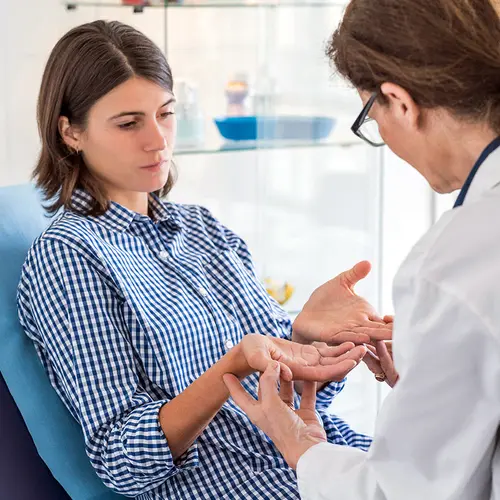It's common for psoriatic arthritis to strike some of the 30-odd joints in the feet, especially the ones in the toes closest to the nail. When it happens to you, just the thought of putting shoes on may make you cringe.
With some kinds of the disease, the points where tendons and ligaments meet bones may get sore, a condition known as enthesopathy. If it affects your Achilles tendon, you'll feel it in your sole or heel, making every step painful.
Medication can help bring down inflammation, ease your symptoms, and prevent joint damage or deformity. Shoes that fit properly and good flexibility in your foot muscles will also help you avoid discomfort and get you back on your feet again.
Shoes
Give your feet all the help they can get. Be a smart shopper.
When your toes have swollen into sausages or your nails are peeling away from the bed, it may be painful or impossible to wear traditional shoes. Consider open-toed shoes instead, or look for ones with extra room in the toe box at the front.
Other things to think about for your footwear are:
Sturdy yet soft. You want a shoe that will support your heels, arches, and the balls of your feet. Try to strike a balance between cushioning for comfort and stiffness for support. Shoes with shock-absorbing rubber soles are a good choice.
Cover up. Protect swollen and sore toes from further injury. Sandals that cradle your foot in a deep footbed or full-coverage shoes both provide a barrier between your toes and anything that might hit them.
Not too tight. Make sure your toes have room to wiggle. Allow about a half-inch of space behind your heel.
Stay grounded. High heels may look pretty, but the way they affect your feet isn't. A 1-inch heel is reasonable. And it puts seven times less stress on your feet than one that's 3 inches.
Stretches
Exercise is one of the best things you can do for your joints. Regular stretching may boost your flexibility and lessen pain in your feet.
Achilles tendon: Stand facing a wall, an arm's length away, with one foot in front of the other. Put your hands on the wall for balance. Keep both heels on the floor, bend your front knee, and lean forward gently. Hold for 10 seconds; repeat three times. Then switch feet.
Big toe: Hook a large rubber band around both of your big toes. Use the muscles of your feet (not your legs) to pull each toe toward the other toes of the same foot and away from each other, as far as you can. Hold for 5 seconds; repeat 10 times.
Five toes: Put a rubber band around all the toes on a foot, then stretch them apart as wide as you can. Hold for 5 seconds; repeat 10 times.
If you don't feel better after doing these stretches, ask your doctor to refer you to a physical therapist.

